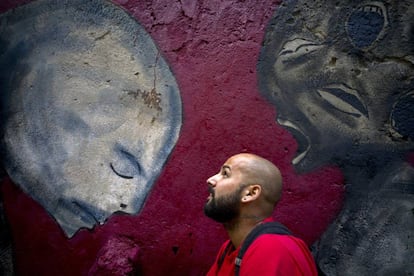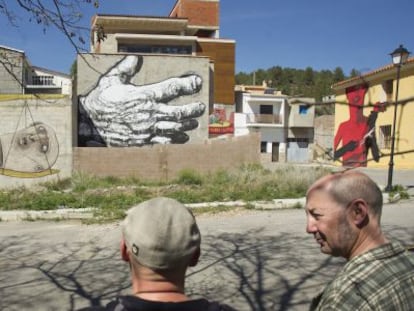Cuban street artist told to remove his work from the walls of Havana
Yulier Rodríguez Pérez insists his paintings are not political, but merely an attempt to make people think


Last week,street artist Yulier Rodríguez Pérez woke up early in his house in Havana and just like any other day, went out to paint. This was until officers arrived at the door of the 27-year-old, born in Camagüey, a city in central Cuba. Pérez, who signs his work as Yulier P., was detained for 48 hours and was released on one condition: “Erase every mural you’ve painted.”
Yulier had no choice: peel your paint, dissolve your murals, remove and erase your artistic sins. Failure to do so would mean being charged with “mistreatment of property.” This Tuesday, by telephone from Havana, he said that he wrote on the back of the agreement he signed that he had not agreed with what he signed at the police station, and therefore, had not moved a finger to erase any of the more than 100 murals he’s painted on the battered walls of the Cuban capital.
Yulier refuses to erase the more than 100 murals he’s painted on decaying facades in Havana
“They want me to mutilate, to self-censure,” he said, adding: “They want me to discredit myself!”
He’s an admirer of Jean Michel Basquiat, the graffiti pioneer from New York who’s SAMO tag covered half of Manhattan, and the British artist Banksy, who is the world’s most famous street artist and who’s identity remains a mystery. Yulier creates his murals on the walls of the many ruined buildings of Havana, a city as beautiful as it is abandoned.
“I always choose places that are in poor condition, are uninteresting and gray,” he says. “I believe I am improving Havana’s image, as well as stimulating debate about the future we want.” In a country where political talk is avoided, he says that his art is “social” and not “a direct attack on the system.” His aim is to provide “aesthetics to a destroyed city.”
From the streets to the courthouse
Yulier P. says he is unsure what the authorities will do next. The deadline the police gave him to erase his murals is coming up in a few days. He hasn’t erased any of his works, but neither has he started any new ones. He assumes that once time is up, he’s going to be arrested again.
I believe that I am improving Havana’s image, as well as stimulating debate Yulier P.
In that case, he doesn’t believe that the authorities will give him another order to erase his murals, but instead he will be “face arbitrary justice.” A policeman said, “nobody in Cuba is allowed to paint the walls” because “that damages public adornment.”
In Cuba, all walls belong to the state. Public areas are filled with propaganda and few people dare to express their views. Danilo Maldonado is another street artist who has disobeyed the authorities and paid for it. He describes himself as an opponent to the regime and has been arrested three times.
“It’s an attempt to humiliate me,” complains Yulier P. His drawings, which he defines as “expressionist figurative,” are made up of naked beings with extraterrestrial bodies that inhabit the corners of the bare planet of Havana. Some of his characters smile, others have sad eyes, others are curious, and some are in panic. He also likes to draw the occasional rabbit with two long ears. But now his murals have come up against Cuba’s toughest art critic, the state.
English version by Debora Almeida.
Tu suscripción se está usando en otro dispositivo
¿Quieres añadir otro usuario a tu suscripción?
Si continúas leyendo en este dispositivo, no se podrá leer en el otro.
FlechaTu suscripción se está usando en otro dispositivo y solo puedes acceder a EL PAÍS desde un dispositivo a la vez.
Si quieres compartir tu cuenta, cambia tu suscripción a la modalidad Premium, así podrás añadir otro usuario. Cada uno accederá con su propia cuenta de email, lo que os permitirá personalizar vuestra experiencia en EL PAÍS.
¿Tienes una suscripción de empresa? Accede aquí para contratar más cuentas.
En el caso de no saber quién está usando tu cuenta, te recomendamos cambiar tu contraseña aquí.
Si decides continuar compartiendo tu cuenta, este mensaje se mostrará en tu dispositivo y en el de la otra persona que está usando tu cuenta de forma indefinida, afectando a tu experiencia de lectura. Puedes consultar aquí los términos y condiciones de la suscripción digital.










































